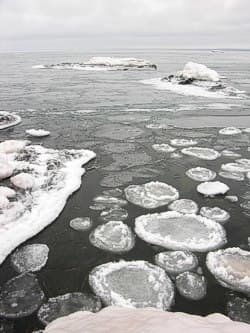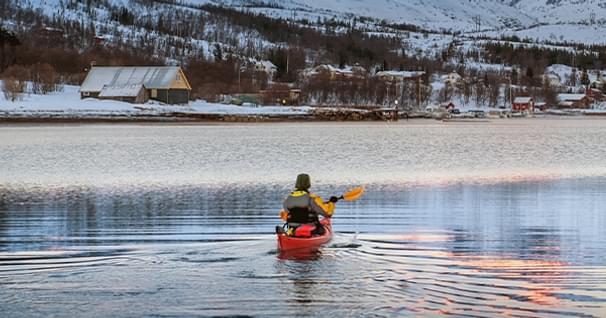Safe Cold-Water Kayaking
"One of the reasons there are so many terms for conditions of ice is that the mariners observing it were often trapped in it, and had nothing to do except look at it."
- Alec Wilkinson
When you love being on the water, winter can be a very long time, especially for those of us who live in the Great Lakes region of the northern U.S., where paddlers often cannot find open water for half the year. But with the proper safety gear and other precautions, we can indeed venture out into a snowy, icy, otherworldly place, where even our usual paddling environs seem fresh and exotic. Of course, it is this very alien nature of the frozen environment which makes it so dangerous. Let's take a look at how to address some of the hazards of cold-water kayaking.
Addressing Cold-Water Kayaking Hazards
Hypothermia and Drowning
The primary hazard, of course, is the cold. Cold winter air temperatures, even when engaged in an aerobic activity like paddling, can pose their own threats to comfort and safety. But outright immersion in ice-cold water is a grave peril indeed, and one can soon see why EMTs and other emergency responders regard such rescues as some of the most hazardous.
Taken separately, hypothermia and drowning can be forestalled for quite some time: there are numerous reports of victims of severe cold surviving upwards of 5-6 hours before successfully responding to proper CPR and medical rewarming techniques, while drowning can be avoided for as many hours as the victim is able to keep one’s head above water.
Given enough time, of course, either of these twin dangers can weaken and kill their victim. But when hypothermia and drowning join forces, even the strongest swimmer will soon succumb to death.
The usual mechanism is hypothermia caused by full immersion in very cold water. This soon leads to severe loss of dexterity, clouded mental faculties, and exhaustion or unconsciousness, which in turn leads directly to the inability to keep one’s head above water, resulting in drowning. See the references below for some sobering insights into how hypothermia kills.
There is an oft-cited old sailors' adage of 50/50/50: a victim immersed in 50F-degree water for 50 minutes stands about a 50% chance of survival. But recent research into cold-water immersion indicates these times and survival rates are overly optimistic, and certainly do not apply to paddlers, who need to actively participate in their own rescues.
As with most paddling safety, the key is a multi-tiered structure: prudent practices to prevent cold, dependable safety gear to forestall the onset of debilitating hypothermia in case of immersion, and emergency supplies to aid in recovering from such an immersion.
Take a Buddy
While I often enjoy summer solo kayaking even in open waters, cold-water paddling offers a much slimmer margin of error. A capsize that is inconvenient in July can be a sudden death sentence in January. So always take a partner, or two.
Proper Cold-Water Clothing
Though always advisable to "dress for immersion", this is no truer than when paddling in winter or other very cold waters.

As usual, the main theory of clothing 'layering' should be followed: snug moisture-wicking undergarments, followed by heavier insulated layers to retain body heat, followed by a waterproof outer shell to prevent all water intrusion. This last is undeniably a kayaking drysuit: a full-length jumpsuit made of a breathable waterproof fabric, with integrated seals at the wrists, neck, and sometimes ankles to keep the wearer completely dry inside.
Neoprene wetsuits certainly have their place, but that place is not very cold water, since they simply lack the necessary ability to prevent the rapid loss of body heat. If and when you ever arrive at that dark day when you require a cold-water rescue, the Coast Guard or EMT will be wearing a functioning drysuit, and you should, too.
The drysuit will keep your core and limbs completely dry, but what about yer noggin? In fact, all the extremities require additional protection: head, hands, and feet.
At the very least, one should wear a full-coverage synthetic-knit cap. Even better in windy or wet conditions is a polyester fleece or water-shedding neoprene hood or balaclava. Waterproof neoprene wetsuit gloves with synthetic-knit liners will help keep hands warm and allow for manual dexterity in the case of a rescue. Wear heavy synthetic socks with liners inside your drysuit feet, with regular wetsuit booties over top of all (you may need booties one size larger than usual for such use).
The Kayak and Other Gear
Composite, polyethylene, even skin-on-frame kayaks can all be used in cold waters—the latter was invented in the Arctic regions, after all! But if you anticipate doing a lot of scraping on jagged shards of ice, or need to drag your boat over rough ground and snow to get to the water, you may opt for your durable plastic kayak.

As usual, adequate flotation is important in case of a capsize, but is crucial in very cold waters. A snug neoprene sprayskirt/spraydeck will keep you warmer inside your boat and keep cold water out of your lap.
Though I typically carry a handheld VHF marine radio only on the open waters of the Great Lakes, it's wise to have one along even on inland waterways during the winter, as an extra communication tool.
Especially in the early spring, winter fog can form over large sheets of ice, perhaps enough to obscure your surroundings. Always use a compass to keep your bearings.
In addition to your usual bailout bag containing emergency supplies, wintertime outings require emergency thermal underclothes carried somewhere securely in a drybag, should you or someone in your party need them after a cold-water dunking. Also, chemical heat packs and a thermos of coffee, tea, or even hot water to aid in treating early hypothermia.
Technique
As winter progresses and local lakes and rivers assume their annual solid state, open water for paddling can become increasingly difficult to find. A good place to look for a decent launch spot is where a river or large stream empties into a lake; the warmer and faster-moving water resists freezing solid, and will often create an area of open water in an otherwise frozen lake.
With the onset of winter, lakes and ponds tend to freeze over from the shallow edges first, leaving open water in the center until it too eventually freezes solid. The spring thaw sees the inverse: open water along the shores with large ice sheets and pack ice in the middle of the lake.

Of course, wind and waves can move such sheets of drift ice and smaller 'pancake' ice around, even piling it up on downwind shorelines. When large ice sheets begin to melt or break up, fractures or cracks called 'leads' will form in them, small at first but often large enough for a kayak, perhaps eventually wide enough for Shackleton's Endurance.
If your path becomes too narrow to paddle easily, you may need to brace on the ice. Be careful to lean only on white or clear ice, as the darker color of 'black ice' often indicates that it is waterlogged and weak. Such ice is not as buoyant and can suddenly give way beneath the pressure of a paddle, allowing you to capsize.
Avoid applying too much weight to a paddle blade or it can be overstrained and break. If you need to scuttle along over or along the ice, try to keep the paddle aligned along the boat as though set up for a stern rudder and 'pole' yourself along, rather than reaching outward and applying a wide low brace-type effort, which can damage a paddle.
Kayaking in extremely cold water presents its own obvious dangers, but the greatest hazard may be the ice itself. If there is any kind of wind or waves, stay off the water; even a small chunk of drift ice can weigh hundreds of pounds and cause real injury if tossed onto your decks.
The marginal zone at the edges of the ice sheets can make for some of the most dramatic and intriguing paddling, but it can also be the most treacherous. Should a paddler capsize here, wind or surface currents can carry the victim beneath the ice sheet to drown unless he is able to extricate himself or is rescued by another paddler.
The edge of an ice sheet itself may appear a safe refuge, but is often quite thin and will frequently break off beneath the weight of a swimmer, who can easily exhaust himself attempting to crawl up to safety.
Paddle Safe! Done wisely and safely, kayaking among the ice floes allows the prepared paddler to fancy himself an Arctic explorer. Dress warm, take a buddy, and stay upright!
Jeffrey Lee edits Superior Paddling, a kayaking website that seeks to inform, inspire, and compel sea-kayakers to explore and appreciate the endless possibilities of paddling and kayak-touring in the upper Great Lakes region. He considers himself an "enthusiastic student" of the art of sea kayaking.
Related Articles
Gliding through glass on a crisp, winter morning can be an experience like no other. Whether we’re…
If you paddle in cold weather and/or cold water, you may want to invest in a dry suit. Wearing a dry…
Wondering what to wear when going paddling? Answer 4 quick questions and instantly learn what you need…
If you've started planning full day-long trips, weekend trips, or multi-day trips on flat, open water,…



